|

from
DrRathFoundation Website
The most powerful German economic
corporate emporium in the first half of this century was the
Interessengemeinschaft Farben or
IG Farben, for short.
Interessengemeinschaft stands for "Association of Common
Interests" and was nothing other than a powerful cartel of,
...and other German chemical and
pharmaceutical companies.
IG Farben was the single largest donor
to the election campaign of Adolph Hitler.
One year before Hitler
seized power, IG Farben donated 400,000 marks to Hitler and his Nazi
party. Accordingly, after Hitler's seizure of power, IG Farben was
the single largest profiteer of the German conquest of the world,
the Second World War.
|
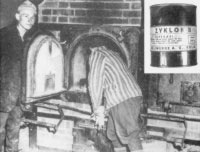
Zyklon-B, an
extermination gas produced by Hoechst, was used to kill
millions of innocent people, before their corpses were burnt |
One hundred percent of all explosives and one hundred percent of all
synthetic gasoline came from the factories of
IG Farben.
Whenever
the German Wehrmacht conquered another country, IG Farben followed,
systematically taking over the industries of those countries.
Through this close collaboration with
Hitler's Wehrmacht, IG Farben participated in the plunder of,
-
Austria
-
Czechoslovakia
-
Poland
-
Norway
-
Holland
-
Belgium
-
France,
...and all other countries conquered by the Nazis.
The U.S. government investigation of the factors that led to the
Second World War in 1946 came to the conclusion that without IG
Farben the Second World War would simply not have been possible.
We
have to come to grips with the fact that it was not a psychopath,
Adolph Hitler, or bad genes of the German people that brought about
the Second World War.
Economic greed by companies like Bayer, BASF
and Hoechst was the key factor in bringing about the Holocaust.
No one who saw Steven Spielberg's film "Schindler's List" will
forget the scenes in the concentration camp Auschwitz.
Contents
The Birth of
IG Farben and the Support for Hitler
(from the book "Sword And
Swastika" by Telford Taylor)
After the First World War, all the major chemical concerns were
merged in 1926 into a single gigantic trust - the I.G.
Farbenindustrie A.G. - under the leadership of Carl Duisberg and
Carl Bosch.
Dyestuffs, pharmaceuticals, photographic supplies,
explosives, and a myriad of other products poured forth in
ever-growing volume and variety.
Soon after the election of July, 1932, in which the Nazis had
doubled their vote, Heinrich Buetefisch [chief of the I.G. Farben -
Leuna plant] and Heinrich Gattineau [a Farben official who was also
an SA officer and personally known to both Rudolf Hess and Ernst
Roehm], waited upon the Fuehrer-to-be to learn whether Farben could
count on governmental support for its synthetic gasoline program in
the event the Nazis should attain power.
Hitler readily agreed that Farben should be given the necessary support to warrant expansion of
the Leuna plant.
After the seizure of power, Farben lost no time in following up this
auspicious introduction. Significantly, Farben's chosen channel was
not the Heeresleitung but Hermann Goering's new Air Ministry. In a
long letter to Goering's deputy Erhard Milch, Carl Krauch of Farben
outlined a "four-year plan" for the expansion of synthetic fuel
output.
Milch thereupon called in
Generalleutnant von Vollard Bockelberg, Chief of the Army Ordnance
Office, and it was agreed that the Army and the Air Ministry
together would sponsor the Krauch project.
A few months later Farben
received a formal Reich contract calling for the enlargement of
Leuna so that production would reach three hundred thousand tons per
year by 1937, with Farben's sales guaranteed for ten years - until
June 30, 1944 - on a cost-plus basis.
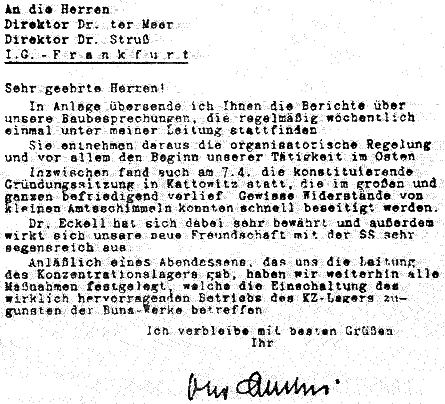
1941: I.G. Farben's
"friendship" with the SS helps
to increase the speed
of construction of Auschwitz-Buna against the resistance "of some
little bureaucrats".
A letter from Dr.
Otto Ambros to the Director of I.G. Farben Frankfurt, Fritz ter Meer
Back to Contents
I.G. Farben
and the Auschwitz Concentration Camp
|
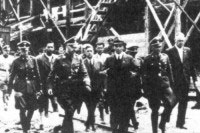
On March 1,
1941, the Reichsführer of the SS, Heinrich Himmler,
inspected the construction site |
Auschwitz was the largest mass extermination factory in human
history, but the concentration camp was only the appendix.
The main project was IG Auschwitz, a 100% subsidiary of IG Farben,
the largest industrial complex of the world for manufacturing
synthetic gasoline and rubber for the conquest of Europe.
On April 14, 1941, in Ludwigshafen, Otto Armbrust, the IG Farben
board member responsible for the Auschwitz project, stated to his IG
Farben board colleagues, "our new friendship with the SS is a
blessing. We have determined all measures integrating the
concentration camps to benefit our company."
The pharmaceutical departments of the IG Farben cartel used the
victims of the concentration camps in their own way: thousands of
them died during human experiments such as the testing of new and
unknown vaccines.
There was no retirement plan for the prisoners of IG Auschwitz.
Those who were too weak or too sick to work were selected at the
main gate of the IG Auschwitz factory and sent to the gas chambers.
Even the chemical gas Zyklon-B used for the annihilation of millions
of people was derived from the drawing boards and factories of IG
Farben.
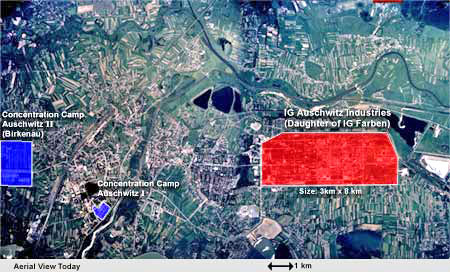
The map of Auschwitz
(above) speaks for itself.
The size of the IG
Auschwitz plant (red area) was larger than
all Auschwitz
concentration camps (blue area) taken together.
Back to Contents
Medical
Experiments in Auschwitz Conducted by I.G. Farben
(from the book "I.G. Farben - from
Anilin to forced labor" by Jörg Hunger and Paul Sander)
Scientific experiments were also done in other concentration camps.
A decisive fact is that IG employee SS major Dr. med. Helmuth
Vetter, stationed in several concentration camps, participated in
these experiments by order of Bayer Leverkusen.
At the same time as Dr. Joseph Mengele, he experimented in Auschwitz
with medications that were designated "B-1012", B-1034", "3382" or "Rutenol".
The test preparations were not just applied to those prisoners who
were ill, but also to healthy ones.
These people were first infected
on purpose through pills, powdered substances, injections or enemas.
Many of the medications caused the victims to vomit or have bloody
diarrhea. In most cases the prisoners died as a result of the
experiments.
In the Auschwitz files correspondence was discovered between the
camp commander and Bayer Leverkusen.
It dealt with the sale of 150
female prisoners for experimental purposes:
-
"With a view to the planned
experiments with a new sleep-inducing drug we would appreciate
it if you could place a number of prisoners at our disposal (…)"
-
"We confirm your response, but
consider the price of 200 RM per woman to be too high. We
propose to pay no more than 170 RM per woman. If this is
acceptable to you, the women will be placed in our possession.
We need some 150 women (…)"
-
"We confirm your approval of the
agreement. Please prepare for us 150 women in the best health
possible (…)"
-
"Received the order for 150 women.
Despite their macerated condition they were considered
satisfactory. We will keep you informed of the developments
regarding the experiments (…)"
-
"The experiments were performed. All
test persons died. We will contact you shortly about a new
shipment (…)"
A former Auschwitz prisoner testified:
"There was a large ward of
tuberculars on block 20.
The Bayer Company sent medications in
unmarked and unnamed ampoules. The tuberculars were injected
with this. These unfortunate people were never killed in the gas
chambers.
One only had to wait for them to die, which did not
take long (…) 150 Jewish women that had been bought from the
camp attendant by Bayer, (…) served for experiments with unknown
hormonal preparations."
Parallel to the tests by Behringwerke
and Bayer Leverkusen the chemical-pharmaceutical and
serologic-bacteriological department at Hoechst started
experimenting on Auschwitz prisoners with their new typhus fever
preparation “3582”.
The first series of tests had results that were
far from satisfactory. Of the 50 test persons 15 died; the typhus
fever drug led to vomiting and exhaustion. Part of the concentration
camp Auschwitz was quarantined, which led to an extension of the
tests to the concentration camp in Buchenwald.
In the journal of the "department for
typhus fever and viral research of the concentration camp Buchenwald"
we find on January 10th, 1943:
"As suggested by the IG
Farbenindustrie A.G. the following were tested as typhus fever
medications:
a) preparation 3582 <Akridin> of the chem. pharm.
and sero-bact. Department Hoechst – Prof. Lautenschläger and Dr.
Weber – (therapeutic test A)
b) methylene blue, formerly tested
on mice by Prof. Kiekuth, Elberfeld (therapeutic test M)"
The first and also the second series of
therapeutic tests, held in Buchenwald between March 31st and April
11th 1943, had negative results due to insufficient contamination of
the tested prisoners. Neither did the experiments in Auschwitz have
evident successes.
The scientific value of all these experiments, whether ordered by
the IG Farben or not, was in fact zero. The test persons were in bad
physical condition, caused by forced labor, insufficient and wrong
nutrition and diseases in the concentration camp.
Add to this the
generally bad sanitary circumstances in the laboratories.
"The test results in the
concentration camps, as the IG laboratory specialists should
know, could not be compared to results made under normal
circumstances".
The SS physician Dr. Hoven testified to
this during the Nuremberg Trial:
"It should be generally known, and
especially in German scientific circles, that the SS did not
have notable scientists at its disposal. It is clear that the
experiments in the concentration camps with IG preparations only
took place in the interests of the IG, which strived by all
means to determine the effectiveness of these preparations.
They
let the SS deal with the – shall I say – dirty work in the
concentration camps. It was not the IG’s intention to bring any
of this out in the open, but rather to put up a smoke screen
around the experiments so that (…) they could keep any profits
to themselves.
Not the SS but the IG took the initiative for the
concentration camp experiments."
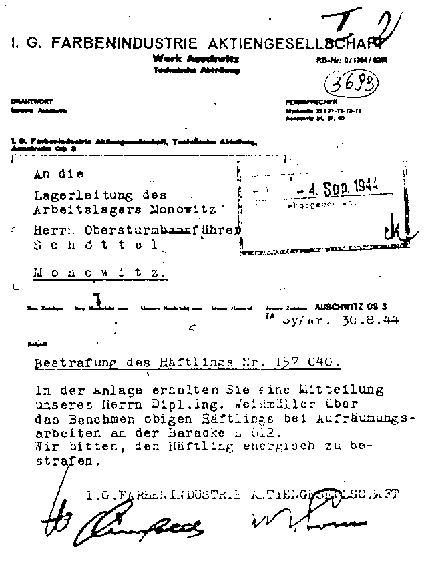
A letter from 1944 in
which I.G. Farben orders
an "energic
punishment" for a slave laborer in Auschwitz-Monowitz.
Back to Contents
The Nuremberg
War Tribunal
The Nuremberg War Criminal Tribunal convicted 24 IG Farben board
members and executives on the basis of mass murder, slavery and
other crimes against humanity. Amazingly however, by 1951 all of
them had already been released, continuing to consult with German
corporations.
The Nuremberg Tribunal dissolved the IG Farben into
Bayer, Hoechst, and BASF.
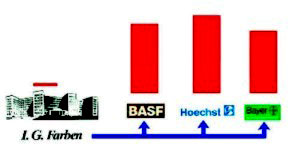
Today each of the three daughters of the
IG Farben is 20 times as big as the IG Farben mother was at its
height in 1944, the last year of the Second World War.
More importantly, for almost three decades after the Second World
War, BASF, Bayer and Hoechst (now Aventis) each filled its highest
position, chairman of the board, with former members of the Nazi,
NSDAP:
-
Carl Wurster, chairman of the board
of BASF until 1974 was, during the war, on the board of the
company manufacturing Zyklon-B gas
-
Carl Winnacker, chairman of the
board of Hoechst until the late 70's, was a member of the Sturm
Abteilung (SA) and was a member of the board of IG Farben
-
Curt Hansen, chairman of the board
of Bayer until the late 70's, was co-organizer of the conquest
of Europe in the department of "acquisition of raw materials."
Under this leadership the IG Farben daughters, BASF, Bayer, and
Hoechst, continued to support politicians representing their
interests.
During the 50's and 60's they invested
in the political career of a young representative from a suburb of
the BASF town of Ludwigshafen, his name: Helmut Kohl.
From 1957 to 1967 the young Helmut Kohl was a paid lobbyist of the "Verband
Chemischer Industrie," the central lobby organization of the German
pharmaceutical and chemical cartel.
Thus, the German chemical and
pharmaceutical industry built up one of its own as a political
representative, leaving the German people with only the choice of
final approval.
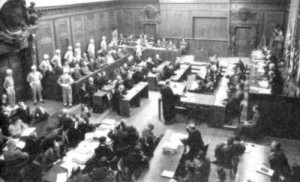
Nuremberg War
Tribunal 1946/47:
24 managers of
Hoechst, Bayer and BASF were indicted
for mass murder,
slavery and other crimes against humanity.
The result is well known: Helmut Kohl
was chancellor of Germany for 16 years and the German pharmaceutical
and chemical industry became the world’s leading exporter of
chemical products, with subsidiaries in over 150 countries, more
than IG Farben ever had.
Several billion people will now die
prematurely, if the pharmaceutical industry gets its way.
Germany is the only country in the
entire world in which a former paid lobbyist for the chemical and
pharmaceutical cartel was head of the government. In summary, the
support of German politics for the global expansion plans of the
German pharmaceutical and chemical companies has a 100-year-old
tradition.
It is with this background that we
understand the support of Bonn for the unethical plans of the
Codex Commission.
(Remark made by the Dr. Rath
Health Foundation)
The U.S. lead prosecutor in the
Nuremberg War Criminal Tribunal against the IG Farben anticipated
this development when he said,
"these IG Farben criminals, not the
lunatic Nazi fanatics, are the main war criminals.
If the guilt
of these criminals is not brought to daylight and if they are
not punished, they will represent a much greater threat to the
future peace of the world than Hitler if he were still alive."
Back to Contents
The Disgraced
Managers of IG Farben
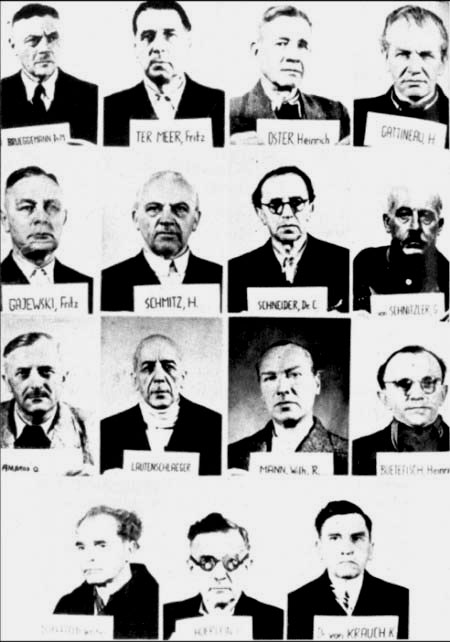
Fritz ter Meer
(1884-1967)
-
Member of the IG FARBEN
executive committee 1926-1945, member of the working
committee and the technical committee, director of section
II
-
1943 plenipotentiary for Italy
of the Reich Minister for armaments and war production,
military economist chief industrialist responsible for
Auschwitz.
-
1948 found guilty of
"plundering" and "enslavement" and condemned to seven years
detention. Released 1952.
-
1955 board member of Bayer
-
1956-1964
-
chairman of the board
of Bayer chairman of the board of Th. Goldschmidt AG,
-
deputy
chairman of the board of Commerzbank bank association AG,
-
board member of the Waggonfabrik Uerdingen,
-
the Duesseldorfer waggonfabrik AG,
-
the bank association West
Germany AG
-
the United Industrial enterprises AG (VIAG)
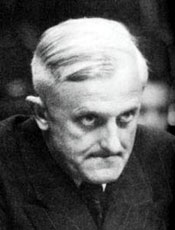 Otto Ambros
(1901-): Otto Ambros
(1901-):
-
Member of the IG FARBEN
executive committee 1938-1945, member of the chemical
committee and chairman of commission K (agents), special
advisors of Krauchs F+E department for the four-year plan,
director of the special committee C (chemical agents), the
main committee for powders and explosives in the office for
arms, military industrial leader
-
Responsible for choice of
location, planning, building and running of IG Auschwitz as
operations manager. Managing director of the Buna-Works and
synthetic fuel production
-
1945 knight's cross
Distinguished Service Cross
-
1948 found guilty of
"enslavement" condemned to eight years detention.
-
Released 1952.
-
Starting from 1954 chairman,
deputy chairmen and member of the boards of:
-
Chemie
Grünenthal, Pintsch Bamag AG,
-
Knoll AG,
-
Feldmühle Papier-
und Zellstoffwerke, Telefunken GmbH,
-
Grünzweig & Hartmann,
Internationale Galalithgesellschaft,
-
Berliner Handelsgesellschaft,
-
Süddeutsche Kalkstickstoffwerke,
-
Vereinigte Industrieunternehmungen (VIAG)
-
with its daughter
enterprises Scholven-Chemie and Phenol-Chemie
-
as an advisor
to F. K. Flickund of the US Industrialist J.P. Grace is
entangled in the early eighties in the "Flick scandal"
Hermann Schmitz
(1881-1960)
-
Member of the IG FARBEN
executive committee 1926-1935, chairman of the board
1935-1945 and "chief of finances" to the IG
-
Military industrial leader,
member of the Nazi party (NSDAP)
-
1941 war Distinguished Service
Cross 1st. Class
-
1948 found guilty of
"plundering" condemned to four years prison.
-
Released 1950.
-
1952 board member of the German
bank Berlin West
-
1956 honorary chairman of the
board of Rheini steel plants.
Fritz Gajewski
(1888-1962)
-
Member of the IG FARBEN
executive committee 1931-1945, leader of section III
(coordination with Dynamite Nobel)
-
At Nuremberg, found "not
guiltily" for all charges
-
1949 managing director, 1952
chairman of the board of Dynamite Nobel AG
-
1953 Distinguished Service Cross
of the Federal Republic of Germany
-
1957 retirement,
-
honorary
chairman of the board of Dynamite Nobel AG,
-
chairman of the
board of Genschow & Co. and the Chemie-Verwaltungs AG,
-
board
member of Huels AG and the Gelsenkirchener mines
Heinrich Buetefisch
(1894-1969)
-
Member of the IG FARBEN
executive committee 1934-1945, deputy director of section I,
director of gasoline synthesis for IG Auschwitz
-
1932 (together with Gattineau)
had the conversation with Hitler, that defined the petrol
pact, 1936 co-worker of Krauch on the four year plan as a
production representative for Öl in the Arms Ministry
-
SS Obersturmbannführer, military
industrial leader, awarded the "friend of the Reich leader
SS" cross.
-
1948 found guilty of
"enslavement" condemned to six years detention.
-
Released 1951.
-
1952 supervisory board member of
Ruhr-Chemie and Kohle-Öl-Chemie among others.
-
1964 Distinguished Service Cross
of the Federal Republic of Germany. The award was taken back
after 16 days due to the violent protests
Friedrich Jaehne
(1879-1965)
-
Member of the IG FARBEN
executive committee 1934-1945, chief engineer of the IG,
deputy director of the BG central Rhine/Maingau
-
1943 military industrial leader,
Distinguished Service Cross 1st. Class 1948 found guilty of
"plundering" condemned to 18 months detention
-
1955 supervisory board member of
the "new" Farbwerke Hoechst. In the same year elevated to
supervisory board chairman elect – Karl Winnacker said "in
the meantime the liquidation conclusion law had been issued
and freed us from all discriminating regulations. So we
could add Friedrich Jaehne, chief engineer of the old IG, to
the supervisory board. He presided over this committee until
1963. None of us would have thought in 1945 that we would
come to such a co-operation".
-
Supervisory board chairman of
the Alfreds Messer GmbH (late Messer Griesheim), supervisory
board member with Linde
-
1959 Dr. Ing. E.h. of TH Munich,
1962 Bayer service medal, honorary senator of TH Munich,
Distinguished Service Cross of the Federal Republic of
Germany
Carl Krauch
(1887-1968)
-
Member of the IG FARBEN
executive committee 1926-1940, chairman of the board
1940-1945, director of the coordination center W, director
of the Reich office for economics, plenipotentiary for
special questions on chemical production, military
industrial leader.
-
1943 knight's cross for
distinguished service.
-
1948 found guilty of
"enslavement" and condemned to six years prison.
-
Released 1950.
-
1955 board member of Huels GmbH.
-
In the Frankfurt 1956 Auschwitz
court case is quoted as saying: "they were usually
anti-social elements so called political prisoners"
(describing the prisoners of Auschwitz-Monowitz)
Carl Wurster
(1900-1974)
-
Member of the IG FARBEN
executive committee 1938-1945, director of BG upperRhine,
board member of DEGESCH
-
Military industrial leader and
Reich calculation chamber of economics
-
1945 knight's cross
Distinguished Service Cross
-
At Nuremberg, found "not
guiltily" of all charges
-
1952
-
chairman of the board of
the "new" BASF,
-
chairman of the board for Duisburger
Kupferhuette and Robert Bosch AG,
-
board member of Augusts Viktoria,
-
the Buna-Werke Huels GmbH,
-
the Süddeutschen Bank,
-
Deutschen Bank,
-
Vereinigten Glanzstoff,
-
BBC,
-
Allianz,
-
Degussa,
-
1965 retirement as chairman of the board of BASF
-
1952 honorary professor of the
University of Heidelberg, Dr. rer. RK h.c. the University of
Tübingen,
-
1953 Dr. Ing. E.h. of the TH Munich,
-
1955
Distinguished Service Cross of the Federal Republic of
Germany, Bayer service medal,
-
1960 Dr. rer. pole h.c. the
University of Mannheim, honorary senator of the Universities
of Mainz, Karlsruhe and Tübingen, honorary citizen of the
University of Stuttgart, honour citizen of the city of
Ludwigshafen,
-
1967 Schiller prize of the city of Mannheim,
president of the federation of the chemical industry,
vice-president of the Max-Planck company, the company of
German chemists.
Back to Contents
From "Arbeit
macht frei" to "Codex Alimentarius"
|
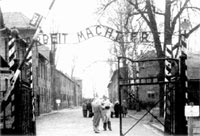
The entrance of
the Auschwitz Concentration Camp |
Just fifteen years after they were
convicted in the Nuremberg War Crimes Tribunal, Bayer,
BASF and
Hoechst were again the architects of the next major human rights
offences.
In 1962, they established the Codex Alimentarius
Commission.
(Remark made by the Dr. Rath
Health Foundation)
This dark period of German history is
inextricably bound to one man, Fritz ter Meer:
-
He was a member of the Managing
Board of IG Farben from its inception to its dissolution. As the
Wartime Manager, he was responsible for IG Auschwitz.
-
In the Nuremberg Tribunal, ter Meer
stated: "Forced labor did not inflict any remarkable injury,
pain, or suffering on the detainees, particularly since the
alternative for these workers would have been death."
-
In 1948, ter Meer was sentenced by
the Nuremberg Tribunal to seven years in prison for plundering
and slavery.
-
In 1952, his sentence was commuted,
due to the influence of powerful friends.
-
From 1956-1964, he was reinstated as
a member of the Managing Board of Bayer AG.
In 1962, ter Meer was one of the
architects of the "Codex Alimentarius"-Commission and one of
the main designers of the schemes that would profit from human
suffering.
(Remark made by the Dr. Rath
Health Foundation)
The deceptive title "Codex Alimentarius" is no accident. It was devised by the same firms
and indeed the same individuals, who gave the Auschwitz
concentration camp inmates the deceptive slogan "Arbeit mach
frei" ("Work makes you free").
(Remark made by the Dr. Rath
Health Foundation)
As long as the Nazi infection continues
to work its influence and threaten the lives of untold millions, no
German has the right to proclaim that the Nazi era is finished.
Back to Contents
|










 Otto Ambros
(1901-):
Otto Ambros
(1901-): 